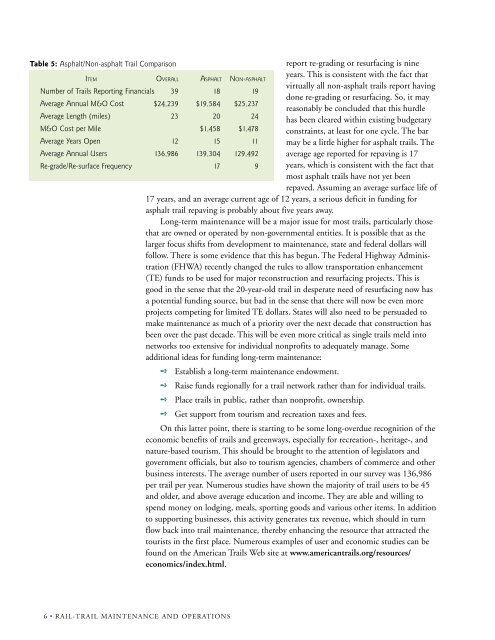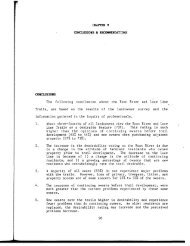Trail Maintenance and Operation - Rails-to-Trails Conservancy
Trail Maintenance and Operation - Rails-to-Trails Conservancy
Trail Maintenance and Operation - Rails-to-Trails Conservancy
You also want an ePaper? Increase the reach of your titles
YUMPU automatically turns print PDFs into web optimized ePapers that Google loves.
Table 5: Asphalt/Non-asphalt <strong>Trail</strong> Comparison<br />
report re-grading or resurfacing is nine<br />
years. This is consistent with the fact that<br />
ITEM OVERALL ASPHALT NON-ASPHALT<br />
virtually all non-asphalt trails report having<br />
Number of <strong>Trail</strong>s Reporting Financials 39 18 19<br />
done re-grading or resurfacing. So, it may<br />
Average Annual M&O Cost $24,239 $19,584 $25,237<br />
reasonably be concluded that this hurdle<br />
Average Length (miles) 23 20 24<br />
has been cleared within existing budgetary<br />
M&O Cost per Mile $1,458 $1,478 constraints, at least for one cycle. The bar<br />
Average Years Open 12 15 11 may be a little higher for asphalt trails. The<br />
Average Annual Users 136,986 139,304 129,492 average age reported for repaving is 17<br />
Re-grade/Re-surface Frequency 17 9 years, which is consistent with the fact that<br />
most asphalt trails have not yet been<br />
repaved. Assuming an average surface life of<br />
17 years, <strong>and</strong> an average current age of 12 years, a serious deficit in funding for<br />
asphalt trail repaving is probably about five years away.<br />
Long-term maintenance will be a major issue for most trails, particularly those<br />
that are owned or operated by non-governmental entities. It is possible that as the<br />
larger focus shifts from development <strong>to</strong> maintenance, state <strong>and</strong> federal dollars will<br />
follow. There is some evidence that this has begun. The Federal Highway Administration<br />
(FHWA) recently changed the rules <strong>to</strong> allow transportation enhancement<br />
(TE) funds <strong>to</strong> be used for major reconstruction <strong>and</strong> resurfacing projects. This is<br />
good in the sense that the 20-year-old trail in desperate need of resurfacing now has<br />
a potential funding source, but bad in the sense that there will now be even more<br />
projects competing for limited TE dollars. States will also need <strong>to</strong> be persuaded <strong>to</strong><br />
make maintenance as much of a priority over the next decade that construction has<br />
been over the past decade. This will be even more critical as single trails meld in<strong>to</strong><br />
networks <strong>to</strong>o extensive for individual nonprofits <strong>to</strong> adequately manage. Some<br />
additional ideas for funding long-term maintenance:<br />
➺ Establish a long-term maintenance endowment.<br />
➺ Raise funds regionally for a trail network rather than for individual trails.<br />
➺ Place trails in public, rather than nonprofit, ownership.<br />
➺ Get support from <strong>to</strong>urism <strong>and</strong> recreation taxes <strong>and</strong> fees.<br />
On this latter point, there is starting <strong>to</strong> be some long-overdue recognition of the<br />
economic benefits of trails <strong>and</strong> greenways, especially for recreation-, heritage-, <strong>and</strong><br />
nature-based <strong>to</strong>urism. This should be brought <strong>to</strong> the attention of legisla<strong>to</strong>rs <strong>and</strong><br />
government officials, but also <strong>to</strong> <strong>to</strong>urism agencies, chambers of commerce <strong>and</strong> other<br />
business interests. The average number of users reported in our survey was 136,986<br />
per trail per year. Numerous studies have shown the majority of trail users <strong>to</strong> be 45<br />
<strong>and</strong> older, <strong>and</strong> above average education <strong>and</strong> income. They are able <strong>and</strong> willing <strong>to</strong><br />
spend money on lodging, meals, sporting goods <strong>and</strong> various other items. In addition<br />
<strong>to</strong> supporting businesses, this activity generates tax revenue, which should in turn<br />
flow back in<strong>to</strong> trail maintenance, thereby enhancing the resource that attracted the<br />
<strong>to</strong>urists in the first place. Numerous examples of user <strong>and</strong> economic studies can be<br />
found on the American <strong>Trail</strong>s Web site at www.americantrails.org/resources/<br />
economics/index.html.<br />
6 • RAIL-TRAIL MAINTENANCE AND OPERATIONS







